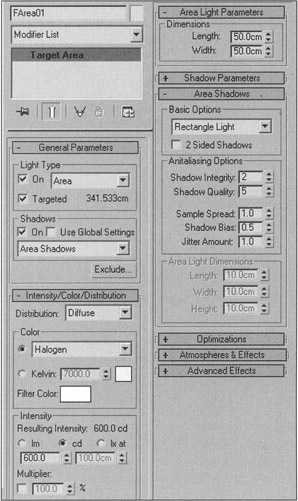Artificial Lighting
|
| < Day Day Up > |
|
Although artificial lighting is beyond the scope of this book, we should mention the new features of 3ds max in this area.
To simplify the work with artificial lighting, a whole class of light sources is provided in 3ds max, called photometrical sources (Photometric Lights). These differ from standard sources because they use physical values to set their parameters. As an example, consider the most demonstrative type: Area Light (Fig. 10.12). This type simulates spatial sources of light (e.g., daylight lamps encapsulated in the plastic cases).

Figure 10.12: Parameters for the Area Light
-
Light Type is the type of light source (Area, in our example). The dimensions of the source of light are in the Area Light Parameters rollout. In this case, these are the dimensions of the luminescent surface.
-
You can select any of the available types of Shadows; in this case, Area Shadows is appropriate. Notice that the dimensions are not controlled in Area Shadows because they are connected to the dimensions of the light source.
-
Distribution distributes light. 3ds max supports several types of distribution, from simple (Isotropic and Diffuse) to physically correct (Web), based on the light distribution diagrams, or goniograms.
-
The Color and Intensity parameters are based on the physical properties of real sources of light. Refer to the manufacturer for information on these.
Notice that the sources of artificial light have no Decay and Attenuation parameters. These properties are specified automatically.
For details on the parameters of the photometrical sources of light, see the "User's Manual."
When these types of light sources are used, the best result is obtained by jointly using the global illumination rendering system and exposure control.
| Note | Despite assurances from the 3ds max developers about the physical correctness and truthfulness of the results obtained with the use of the photometrical sources of light, global illumination systems, and exposure control, you are free to experiment on your own. Don't be upset if you are not satisfied with the results. Try to change all possible parameters to get the best appearance. Combine various methods, or even tint the result in a 2D editor. And don't neglect the filters. In this case, the end justifies the means. |
|
| < Day Day Up > |
|
EAN: N/A
Pages: 136